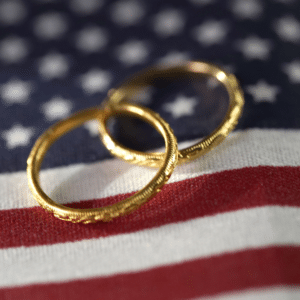
July 6, 2021
Frequently, clients who have partners living outside the United States inquire about the distinctions between a fiancée visa and a marriage visa.
There are many types of visas, so the difference between a fiancée visa and a marriage visa is important to understand. At Casais & Prias, we get questions about this distinction often, and we think it is important to keep our clients informed on these terms.
What is a Fiancé Visa?
A fiancée/fiancé visa is available to couples who are not yet married and one of them is a U.S. citizen (USC). In order to qualify for a fiancée/fiancé visa, the couple must demonstrate an intent to marry each other within 90 days of the fiancée/fiance’s admission to the United States. The couple must also demonstrate that they are both free to marry (meaning they are not currently married and/or all previous marriages have been lawfully terminated) and that the USC and foreign national have met each other in person at least once within the two-year period before the USC files the visa petition. The requirement to meet in person may be waived if it is shown that meeting in person would violate strict and long-standing customs of a foreign culture or social practice or if meeting in person would result in extreme hardship to the USC petitioner. Once the foreign national enters the United States with a fiancée/fiancé visa and is married to the USC within 90 days of admission, the foreign national may then apply to become a lawful permanent resident.
What is a Marriage Visa?
A marriage visa, on the other hand, is for couples who are already married, and one of them is a USC. If the spouse of the USC is living outside the United States, the USC would file a petition on behalf of the foreign spouse with USCIS. Once approved, the case is transferred to the US. Consulate in the foreign national’s home country. The foreign national will then attend an interview at the consulate and, if approved, receive an immigrant visa to enter the United States as an immediate relative (spouse) of a USC. In essence, the foreign national enters the U.S. as a resident.
Furthermore, in cases where the U.S. citizen (USC) and foreign national spouse are married and both are within the United States, the USC can submit a petition to USCIS on behalf of the foreign national. Simultaneously, the foreign national can apply for residency. Once these applications are approved, the foreign national obtains conditional residency if the marriage is less than two years old when the applications are processed. Alternatively, full residency is granted if the marriage spans more than two years at the time of application approval.
Should conditional residency be granted, the USC and the foreign national spouse must initiate the removal of conditions process 90 days before the two-year anniversary of conditional approval. During this phase, the couple must demonstrate their ongoing marriage and cohabitation, presenting evidence of their relationship over the preceding two years. This can include joint ownership of assets and debts, as well as any children born during the marriage.

Still Not Sure About the Difference Between a Fiancé Visa and a Marriage Visa? Call Us Today
If you still have some confusion about the difference between these two types of visas, we encourage you to contact our law office for clarification. Our attorneys are well-versed in immigration law and will be able to clearly explain what you need to know.